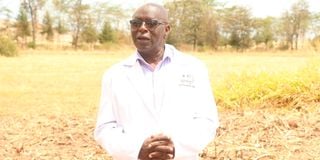Premium
Forage and dual purpose sorghum

Patrick Mwangi, the Deputy Institute Director and Animal Nutritionist at Kalro, during the interview.
New sorghum varieties can be used as forage or for dual purpose. They are early maturing, climate-smart and can actually increase livestock productivity. Seeds of Gold spoke to Patrick Mwangi, the Deputy Institute Director and Animal Nutritionist at the Kenya Agricultural and Livestock Research Organisation (Kalro) in Lanet, Nakuru County.
What is the difference between forage and dual purpose sorghum?
Forage sorghum is purely for purposes of feeding livestock. It has low grain count material, is tall, erect and can attain a height of three metres or more when mature.
The new forage sorghum variety released to the market is E6518. It takes 230 days to mature.
Dual purpose sorghum is animal feed that can also be used as human food. Like forage sorghum, it does well with low moisture. It is 1.7 to 2.5 metres tall when mature.
Improved dual purpose sorghum varieties include E1291, Ikinyaruka, BJ28 and BM30.
Why should farmers go for improved sorghum varieties instead of the traditional ones?
Farmers are advised not to get the seeds from markets, since some have a poisonous chemical called hydrogen cyanide. The chemical is predominant in local sorghum varieties. Animals suffer bloating when fed on such sorghum.
Tannin is also common in local sorghum varieties. Tannin is a complex chemical substance derived from phenolic acids that form part of the grains or forage. The grains are not palatable.
The new fodder and dual purpose sorghum varieties are resistant to cold and drought, compared to other fodder like maize and Napier grass.
The new sorghum varieties can replace maize, silage and grains, considering that they have high energy levels. They can survive drought because of their morphological and physical structures.
The improved sorghum varieties have the ability to regrow c- scientifically known as ratooning. This increases the yield per unit area and reserves feed.
What are the advantages of growing sorghum as an alternative for maize and Napier grass?
The new sorghum varieties are full of energy-giving nutrients. They have high crude protein content compared to maize.
They also have biological mechanisms to block stomata and overcome drought. That means management practices are not costly as the crop is adaptable and less affected by pests and diseases.
The dual purpose sorghum variety matures fast and can be used as human food or for making silage. It does not grow as a single plant as it produces several branches from the main stem.
Fodder sorghum reduces competition for food between humans and livestock.
Sorghum produces more forage than maize. After it is cut for use, farmers can harvest grains, thereby cutting the cost of replanting and land preparation.
In order to improve harvests, how should the farmer take care of the sorghum crop?
Sorghum grains are small. The farmer should ensure the soil is fine when sowing these seeds. The seeds germinate fast in furrows.
Farmers should plant sorghum at a seed rate of 2.4 to 3.3 kilogrammes per acre. The fodder varieties should have a spacing of 75 by 10 centimetres, whereas the dual purpose variety requires a spacing of 60 by 20 centimetres.
Well composed manure should be applied and worked into the soil during the preparation of the land. Organic foliar can be added when the plant is a few centimetres from the ground.
It is advisable to thin at day 30 from planting to ensure enough space between rows of growing fodder and feed sorghum. Other practices are weeding, pest and disease control.
What are some of the challenges Kalro faces as it attempts to promote the growing of the new sorghum varieties?
Small-scale farmers in Kenya prefer maize to sorghum as they do not have much knowledge about the improved varieties and where to get the seeds.
It should be known that sorghum is one of the favourite food for birds. Most of the varieties are attacked by birds, especially when there are no other cereal crops around.
Local farmers may get the sorghum but not of the recommended variety.
Any lessons learnt?
Sorghum forage can be used in a number of ways, key among them as pasture, green chop, hay, silage and crop residues.
Hay sorghum should be chaffed before it is given to livestock in order to avoid wastage. The best stage for ensiling – a technique for preserving – sorghum is the medium.
Grain sorghum should be ensiled when top seeds are in dough stage and the bottom ones are at milky stage.




